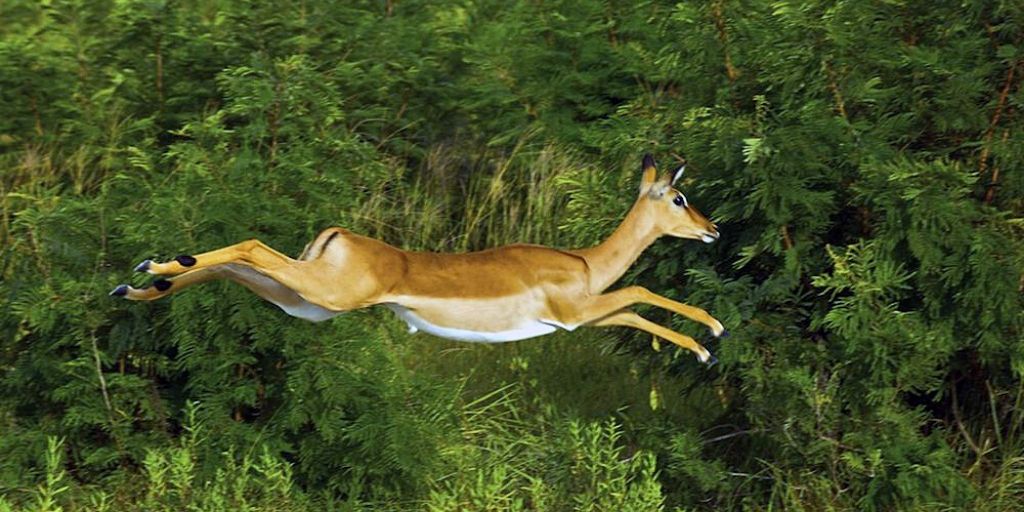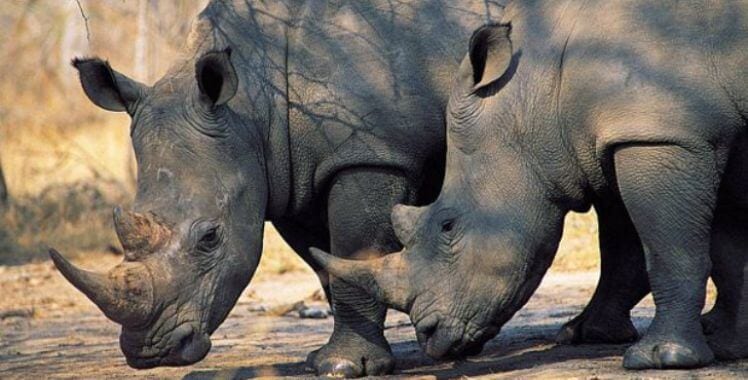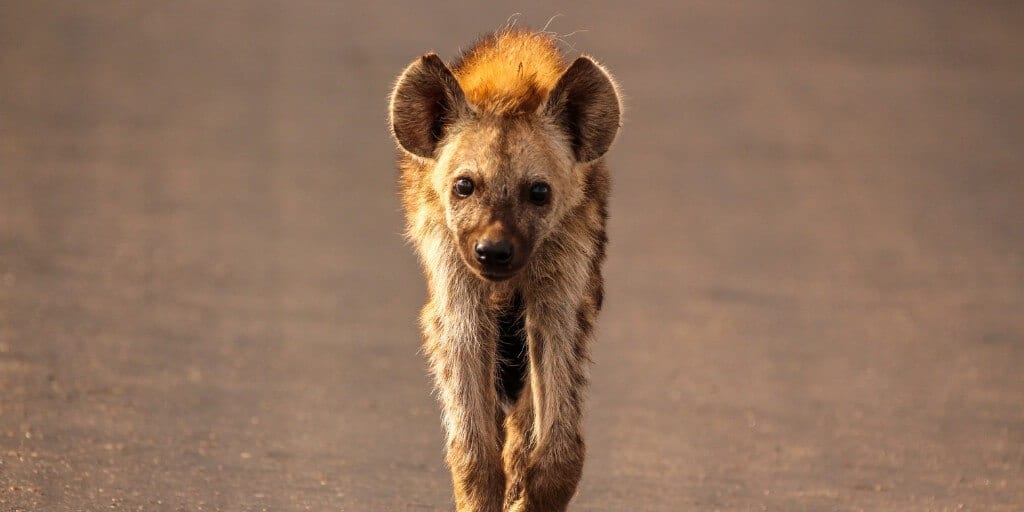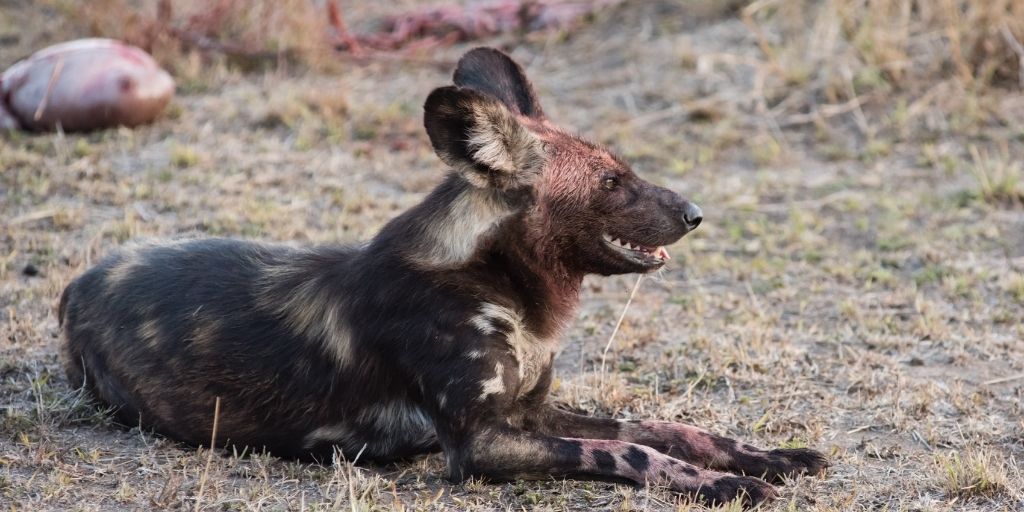How Many Animals Are In The African Savanna
What sort of savanna animals can you expect to see on a safari game drive? Read on below for our take on about iconic animals of the savanna.
Africa is dwelling to many dissimilar habitats – wetlands, deserts, mountains, jungles and many more – but it is on Africa'south savannas that the nearly impressive numbers and selections of wildlife can be found.
What is a savanna?
Savanna is divers every bit dry out regions receiving less than thirty centimeters of precipitation annually, and are formed when regional climate changes result in long-lasting drought weather condition.
Savannas accept year-round warm temperatures and ii distinct seasons. These are:
- A very long dry season (winter) that typically starts with a serial of violent thunderstorms followed by strong dry winds.
- A very wet season (summer) where a pregnant amount of rainfall occurs for simply a few months each twelvemonth. In the Southern Hemisphere this rainy flavor is typically October to March, and in the Northern Hemisphere April to September.
In particular, East Africa's grasslands making up the Serengeti and Masai Mara ecosystem is considered the largest savanna on Globe, and dwelling to literally millions of grazers (wildebeest, zebra, and gazelle), and the many thousands of predators that hunt them. To go on safari in Due east Africa's savanna is about as authentic information technology gets for a traditional safari experience with multiple regular wild fauna sightings guaranteed.
With this in mind, let's wait at 15 of the most iconic savanna animals in Africa:
Aardvark

Juvenile aardvark
Aardvarks live throughout Africa, southward of the Sahara. Their proper name comes from South Africa'due south Afrikaans language and ways 'world hog'. Beingness nocturnal, they spend the hot African afternoons resting in their cool secret burrows, and nighttimes foraging in grasslands and forests for termites.
African bush elephant

Elephant close upward
The African elephant (Loxodonta africana) is the largest and heaviest land fauna in the world, weighing up to half-dozen tonnes. Their distinguishing features include the unique and dexterous elephant body, large ears that absurd the body when flapped, and elongated incisors in the form of tusks. There are really two species of African elephant – the African bush elephant and the smaller African forest elephant. Both are herbivores that live in big groups, whilst the African bush elephant is the larger of the two species, and typically the species referred to equally a member of the large five animals.
A bull elephant tin be dangerous, equally can herds or mothers with young elephants. Keep your distance from them, and if in a vehicle ensure that you have the means to bulldoze abroad forwards – elephants can run faster than a car tin reverse. An elephant flapping its ears, kicking up dust and/or trumpeting is probably well-nigh to charge.
Group name:Herd
Size:Up to 3.3 meters tall, weighing 6,000kg.
Speed:Up to 40 km per hour.
Diet:Elephants are vegetarians, eating upwardly to 160kg per day, made upward of savannah grasses, bushes, small plants, fruit, twigs, tree bark, and roots.
Range & Habitat:African Elephants are found across sub-Saharan Africa – from Mali in the north, through the central and west African forests, down to South Africa. They are adaptable animals, capable of surviving in many habitats, from lush wetlands to arid deserts.
Best places to encounter African Elephant:Addo Elephant Park, South Africa, Chobe National Park, Botswana, Etosha National Park, Namibia, Hwange National Park, Zimbabwe, Southward Luangwa National Park, Zambia.
Caracal

Caracal stalking
Caracal (meaning 'black ears' in Turkish) are common across Africa, and also native to the Centre East, and parts of Asia and India. They are characterized by their stocky trunk on long legs, tufted ears, and uniform sandy colour. At 0.5 meters alpine they weigh in at just 12 kg, and spectacular acrobats, able to jump iii m into the air.
Chetah

Cheetah walking in the sunset
Group proper noun: Coalition.
Size:0.9 metres, weighing up to 72kg.
Speed:With a maximum speed of 92 kilometers per hr, the chetah is the fastest land animal in the world.
Diet: Cheetahs hunt small and medium-sized mammals such as hares, impalas, wildebeest calves, and gazelles, either on their own or in small family unit groups.
Range & Habitat:Cheetahs are found in Eastern and Southern Africa (though are likewise constitute in Iran and Afghanistan), generally confined to very small, fragmented habitats of savanna, dry and scrub forests and grasslands.
Best places to encounter cheetahs:Etosha National Park, Namibia, Kruger National Park, South Africa, Masai Mara National Reserve, Republic of kenya.
Eland

The eland is 1 of the African savanna's most enduring savanna animals. The largest of the antelope family unit, the animal is remarkable for its hitting glaze and impressive, ox-like build. Elands brand a peculiar clicking sound that can be heard from a mile away, the source of which is a field of study of some debate. Some believe information technology's produced by the eland's legs, with others believing it's the eland's spiral hooves that make the sound.
Where to see eland: The eland thrives in the game parks of Republic of kenya, Tanzania, Zambia, Botswana, Republic of zimbabwe, and Southward Africa.
Giraffe

Giraffe mother with two young on the savanna
Perhaps the ultimate icon of the African savanna, the giraffe is an unmistakable land mammal known for its long cervix and spotted glaze. They were known by Arab prophets as the 'queen of the beasts' because of their frail features and graceful poise.
With nine subspecies sharing its distinctive characteristics, this safari animal is the tallest in the world past some fashion. The giraffe's coat is characterised by dark blotches on lighter hair. With age, male giraffes may become darker, and while calves inherit spot patterns from their mothers, each giraffe has a unique coat pattern that sets information technology apart. It has a precipitous sense of hearing and odour, another defense against predators, while it tin can close its nostrils during sandstorms and against ants.
All-time places to encounter giraffe:Etosha National Park in Namibia, Kruger National Park in South Africa, Serengeti National Park in Tanzania, Masai Mara National Reserve in Kenya.
Grant'southward zebra

Zebras drinking on the savanna
Zebras are maybe the nigh stylish of Africa's stars, with their characteristically stunning coats of black and white stripes. These distant relatives of the horse are a frequent sight on any African safari and consist of three different species.
There are many theories about why zebras are striped, and it seems that perhaps the about likely answer is that the stripes part equally a style to deter biting insects like tsetse flies and mosquitos.
Plains zebras play a particularly interesting office in the ecosystem, every bit they are pioneer gazers, nibbling and feeding on the summit-most layer of grass, thereby opening up the grassland for more specialized grazers looking for the short grasses tucked below.
Best places to run across zebra:Etosha National Park, Namibia, Makgadikgadi Pans in Botswana, Masai Mara in Republic of kenya, Okavango Delta in Botswana, Samara Game Reserve in South Africa, Samburu National Reserve in Kenya, Serengeti National Park in Tanzania
Hartebeest

The hartebeest, is a big African antelope, also known as a kongoni. With a camouflaged fawn-color, their near distinctive characteristics are an elongated snout and steeply sloping back. Despite their foreign looks, the hartebeest is one of the fastest animals on the savanna, reaching speeds of shut to 70 kilometers per 60 minutes.
Impala

Impala jumping in lush greenish bushes
The impala is an animal that you shouldn't have too much trouble spotting during your safari. The impala has a lovely red coat matched against a white underbelly, which might seem reminiscent of the springbuck, except non as dramatic a contrast between the two.
The impala is sexually dimorphic, which means that the males and females don't look akin. Where males have horns, the females don't, and it's with these lyre-shaped horns that the males fight off their opponents and rivals. The curved arch ways the horns become interlocked during a skirmish, potentially saving the male person impala from skull impairment or serious wounds.
Jackal

Golden jackal standing in green grass
The jackal is a relatively small canid that is found predominantly in Africa, with some species residing in Southeastern Europe and Asia. The African jackal is known as "Mbweha" in Swahili.
At first glance, the jackal looks like a cantankerous between a play tricks and a German shepherd dog. This is considering it has a small face, delicate legs, fluffy tail, and ears that resemble those of a German language shepherd.
Leopard

Leopard lying on a tree branch
Grouping name:Jump.
Size:one meter high, weighing up to 100 kg.
Speed: 56 km per 60 minutes.
Diet:Leopards are opportunistic carnivores and hunt a wide range of casualty such every bit jackals, antelopes, gazelles, African monkeys, duiker, eland, impala, wildebeest and more.
Range & Habitat:Leopards alive in more places than any other large true cat, and are comfortable in nearly whatsoever habitat, including deserts, rainforests, woodlands, grassland savannas, mount, scrub, and swamps. Leopards are 1 of the few big game species plant outside national parks.
Best places to come across leopards:Londolozi Game Reserve, Due south Africa, Moremi Game Reserve, Republic of botswana, Samburu National Reserve, Kenya, Southward Luangwa National Park, Zambia.
Panthera leo

Lioness scouts for prey on the savanna
Grouping name: Pride.
Size:1.2 meters, weighing upward to 225kg.
Speed:At a maximum speed of eighty kilometers per hour, the lion is the 2d fastest land animal in Africa.
Diet: Lions are apex predators and generally hunt the larger animals in their surroundings – buffaloes, rhinos, zebras, giraffes, and antelopes.
Range & Habitat:Lions tend to prefer grassland, savanna, dense scrub, and open woodland. They are institute beyond sub-Saharan Africa, and also in a small office of due north-eastward India.
All-time places to see Lion:Kgalagadi Transfrontier Park, South Africa, Kruger National Park, South Africa, Maasai Mara National Reserve, Kenya, Ngorongoro Conservation Surface area, Tanzania, Okavango Delta, Botswana.
Ostrich
The common ostrich is the tallest and heaviest bird in the world, with an average height of over 2 meters (sometimes as tall equally two.7 meters) and a weight of upwards to 160 kg. At this size, the ostrich is, of course, a flightless bird, simply can outrun enough of animals with its top speed of 69 km per hour. Their long, powerful legs double upwardly as defensive weapons which pack a powerful kick to would-be predators. Fun ostrich fact – they are able to survive without water for days, generating water internally and extracting water from vegetation.
Rhinoceros

Two southern white rhinos
Rhinos are something you just demand to meet to understand how impressive they actually are. A rhino sighting is always special and as yous wait in awe your heart will definitely skip a beat.
Once widespread through sub-Saharan Africa, the rhino has been hunted to the brink of extinction and is probably the hardest of the big v to spot in the wild. There are two species of rhinoceros in Africa – the black rhino (Diceros bicornis) and the white rhinoceros (Ceratotherium simum).
Whilst white rhinos take fabricated a comeback through conservation efforts across the continent, black rhinos are nevertheless very much one of Africa's endangered animals, and the hardest safari beast to spot. The fundamental differences between the white and black rhino are not color, but rather size, temperament, food preference, and oral fissure shape.
Best places to meet Rhinoceros:Etosha National Park, Namibia,Hluhluwe–Imfolozi Park, South Africa, Lewa Wildlife Conservancy, Kenya, Mkomazi National Park, Tanzania.
Spotted hyena

A hyena cub close upward
Hyenas are unique and vital components of most African ecosystems, both taking advantage of other animals' kills for like shooting fish in a barrel meals and hunting themselves. The size of a hyena impale or scavenge is mostly determined by the size of the hyena'south association, which can run to dozens. They often hide extra food in watering holes, since nothing is wasted. Hyenas will eat every part of an fauna, including bones and hooves.
Hyenas can adapt to almost whatever habitat and are establish in grasslands, woodlands, savannas, forest edges, sub-deserts, and mountains.
Warthog

Warthog walking in long savanna grass
Warthogs are usually plant in family unit groups, where they spend virtually of their fourth dimension either looking for food or wallowing in the mud at waterholes. At night they shelter in burrows, inbound tail beginning.
Warthogs accept a wide distribution across sub-Saharan Africa, with a preference for open woodland and savannahs, and are non endangered.
Wild dog

Wild dog with a encarmine face up
African wild dogs live in packs of around half-dozen-20 and are highly intelligent and sociable. One of the most fascinating sights is the bond they brandish before a hunt; the group begins mingling within the group, vocalising and touching each other, working each other up into a frenzy of excitement. Sadly, these animals are highly endangered
All-time places to come across wild dogs:Hluhluwe-Imfolozi Game Reserve in S Africa, Hwange National Park in Zimbabwe, Kruger National Park in South Africa, Niassa National Reserve in Mozambique, Kwando, Selinda & Linyanti in Botswana, Tswalu Private Biological reserve in South Africa.
Wildebeest

Huge herd of wildebeest meandering through the long yellow grass plains in Tanzania'south Serengeti
Wildebeest are primarily grazers, enjoying the grass, and the occasional shrub and herbs, living in herds of between x and many thousands. They're characterized by a long black mane and a beard of pilus hanging from the pharynx and neck, forth with their short curved horns, with males weighing up to 250kg.
Their preferred habitat is open up grasslands, with their renowned seasonal migration being an optimized survival strategy giving them access to and use of resource over huge areas, minimizing over-grazing during both wet and dry seasons.

African savanna animals list
To a higher place we've looked at the almost iconic African animals establish on the savanna, but there are enough more we didn't embrace. And so here's a complete listing of savanna animals found in Africa:
Savanna birds
African hoopoe
African masked weaver
Flamingo
Lilac breasted roller
Marabou stork
Ostrich
Red and yellow barbet
Cerise-billed oxpecker
Secretary bird
Southern ground hornbill
White-backed vulture
Savana canids
African wild domestic dog
Hyena
Jackal
Savanna cats
Caracal
Cheetah
Leopard
Lion
Savanna reptiles
Adder
African helmeted turtle
African rock python
Black mamba
Common egg-eater
Flap-necked chameleon
Gecko
Leopard tortoise
Meller'due south chameleon
Natal midlands dwarf chameleon
Nile crocodile
Rock monitor lizard
Skink
Southern brown serpent
Savanna ungulates
Blesbok
Bontebok
Common duiker
Eland
Gazelle
Giraffe
Grant'due south Zebra
Hartebeest
Impala
Roan antelope
Springbok
Stenbok
Wildebeest
Other savanna mammals
Aardvark
African elephant
Chacma baboon
Honey badger
Meerkat
Mongoose
Rhinocerous
Warthog
That's our round-up of African animals of the savanna. What did you think – have you seen any of these animals in the wild, or perhaps there's an iconic savanna brute you feel we've left off this list? Allow u.s. know your thoughts in the comments section below!
Source: https://safarisafricana.com/animals/savanna-animals/
Posted by: smithalitill.blogspot.com

0 Response to "How Many Animals Are In The African Savanna"
Post a Comment